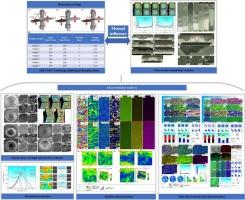异种7075/6061铝合金双面协同搅拌摩擦点焊组织演变及界面形貌优化
IF 5.5
2区 材料科学
Q1 MATERIALS SCIENCE, CHARACTERIZATION & TESTING
引用次数: 0
摘要
本研究介绍了一种新型的双面无探针搅拌摩擦点焊(SDP-FSSW)技术,用于连接力学性能显著不同的铝合金,特别是AA7075-T8和AA6061-T4。主要目的是系统地研究上下工具肩的转速变化对焊缝形成、显微组织演变和接头力学性能的影响。通过独立控制两个工具肩的转速,该工艺能够精确调节界面形态、热量输入和塑性流动,从而实现平整、无缺陷的焊接,并控制钩形形成和显著的材料混合。拉剪试验结果表明,节理强度均在5kn以上。在最佳条件下(600/200 rpm,停留时间仅为3),接头的最大抗拉剪切强度为9585.9 n。这些结果表明,SDP-FSSW对界面形态和接头性能提供了卓越的控制,为先进制造中制造高强度、轻量化、多材料结构提供了巨大的潜力。本文章由计算机程序翻译,如有差异,请以英文原文为准。

Microstructure evolution and Interface morphology optimization in synergistic double-sided probeless friction stir spot welding of dissimilar 7075/6061 aluminum alloys
This study introduces Synergistic Double-Sided Probeless Friction Stir Spot Welding (SDP-FSSW) as a novel solid-state technique for joining dissimilar aluminum alloys, specifically AA7075-T8 and AA6061-T4, which differ markedly in their mechanical properties. The primary objective was to systematically investigate how varying the rotational speeds of the upper and lower tool shoulders affects weld formation, microstructural evolution, and joint mechanical performance. By independently controlling the rotation speeds of both tool shoulders, the process enabled precise regulation of interfacial morphology, heat input, and plastic flow, resulting in flat, defect-free welds with controlled hook formation and significant material intermixing. Tensile-shear tests showed that all joints exhibited strengths above 5 kN. Under optimal conditions—600/200 rpm with a dwelling time of just 3 s—the joint achieved a maximum tensile-shear strength of 9585.9 N. These results demonstrate that SDP-FSSW provides superior control over interface morphology and joint properties, offering significant potential for fabricating high-strength, lightweight, multi-material structures in advanced manufacturing.
求助全文
通过发布文献求助,成功后即可免费获取论文全文。
去求助
来源期刊

Materials Characterization
工程技术-材料科学:表征与测试
CiteScore
7.60
自引率
8.50%
发文量
746
审稿时长
36 days
期刊介绍:
Materials Characterization features original articles and state-of-the-art reviews on theoretical and practical aspects of the structure and behaviour of materials.
The Journal focuses on all characterization techniques, including all forms of microscopy (light, electron, acoustic, etc.,) and analysis (especially microanalysis and surface analytical techniques). Developments in both this wide range of techniques and their application to the quantification of the microstructure of materials are essential facets of the Journal.
The Journal provides the Materials Scientist/Engineer with up-to-date information on many types of materials with an underlying theme of explaining the behavior of materials using novel approaches. Materials covered by the journal include:
Metals & Alloys
Ceramics
Nanomaterials
Biomedical materials
Optical materials
Composites
Natural Materials.
 求助内容:
求助内容: 应助结果提醒方式:
应助结果提醒方式:


